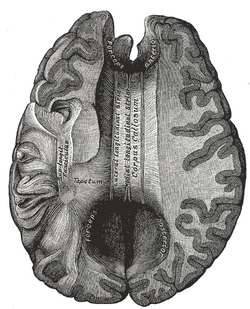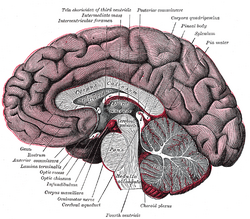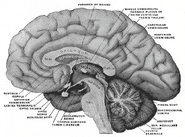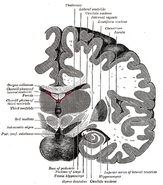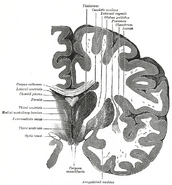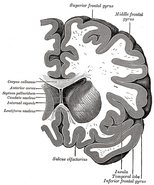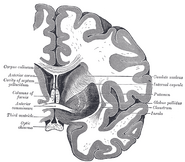Assessment |
Biopsychology |
Comparative |
Cognitive |
Developmental |
Language |
Individual differences |
Personality |
Philosophy |
Social |
Methods |
Statistics |
Clinical |
Educational |
Industrial |
Professional items |
World psychology |
Biological: Behavioural genetics · Evolutionary psychology · Neuroanatomy · Neurochemistry · Neuroendocrinology · Neuroscience · Psychoneuroimmunology · Physiological Psychology · Psychopharmacology (Index, Outline)
| Brain: {{{Name}}} | ||
|---|---|---|
| Corpus callosum from above. (Anterior portion is at the top of the image.) | ||
| Median sagittal section of brain (person faces to the left). Corpus callosum visible at center, in light gray.) | ||
| Latin | ' | |
| Gray's | subject #189 828 | |
| Part of | ||
| Components | ||
| Artery | ||
| Vein | ||
| BrainInfo/UW | hier-173 | |
| MeSH | A08.186.211.730.885.362 | |
The corpus callosum is a structure in the mammalian brain that connects the left and right cerebral hemispheres. It is the largest white matter structure in the brain, consisting of 200-250 million contralateral axon projections. It appears as a wide, flat region just ventral to (below) the cortex. Most (but certainly not all) communication between regions in different halves of the brain are carried over the corpus callosum.
Monotremes and marsupials do not have a corpus callosum.
Regions[]
The posterior portion of the corpus callosum is called the splenium; the anterior is called the genu (or "knee"); between the two is the body.
The most anterior part is the rostrum.
Sexual dimorphism[]
In humans, disputed claims have been made about the importance for gender difference of a difference in size between the corpus callosum in males and females, and analogous racial claims. RB Bean, a Philadelphia anatomist, suggested in 1906 that the "exceptional size of the corpus callosum may mean exceptional intellectual activity" and claimed gender differences which were refuted by Franklin Mall, the director of his own laboratory.[1]
Of much more substantial popular impact was a 1982 Science article claiming to be the first report of a reliable sex difference in human brain morphology and arguing for relevance to cognitive gender differences.[2] This paper appears to be the source of a large number of lay explanations of perceived male-female difference in behaviour: for example Newsweek stated in 1992 that the corpus callosum was "Often wider in the brains of women than in those of men, it may allow for greater cross talk between the hemispheres—possibly the basis for woman’s "intuition". It has also been used, for example, as the explanation of an increased single-task orientation of male, relative to female, learners; a smaller male organ is said to make it harder for the left and right sides of the brain to work together and to explain a feminine ability to multitask.
The relationship between known gender-specific biology (such as males having, in general, higher testosterone levels than females) and claims about behaviour (such as human males being more competitive) remains a highly contested one. Unusually, the scientific dispute in the case of the corpus callosum is not about the implications of biological difference, but whether such a difference actually exists. A substantial review paper performed a meta-analysis of 49 studies and found, contrary to de Lacoste-Utamsing and Holloway, that males have a larger corpus callosum, a relationship that is true whether or not account is taken of larger male brain size.[1] Bishop and Wahlstein found that "the widespread belief that women have a larger splenium than men and consequently think differently is untenable." However, more recent studies using new techniques revealed morphological sex differences in human corpus callosum.[3][4] Whether, and to what extent, these morphological differences are associated with behavioural and cognitive differences between males and females is unclear.
Pathology[]
- Alien hand syndrome
- Not all people have a corpus callosum. A complete or partial absence of it in humans is called agenesis of the corpus callosum.
- Split-brain
- Septo-optic dysplasia (deMorsier syndrome)
External links[]
Additional images[]
References[]
- ↑ 1.0 1.1 Bishop, K.M. and D. Wahlsten. "Sex Differences in the Human Corpus Callosum: Myth or Reality?", Neuroscience and Biobehavioral Reviews, Vol. 21, No. 5, pp. 581–601, 1997.
- ↑ de Lacoste-Utamsing, C., Holloway, R. L. "Sexual dimorphism in the human corpus callosum." Science, 216, 1431–1432, 1982.
- ↑ Dubb A, Gur R, Avants B, Gee J. "Characterization of sexual dimorphism in the human corpus callosum." Neuroimage. 2003 Sep;20(1):512-9.
- ↑ Shin YW, Kim DJ, Ha TH, Park HJ, Moon WJ, Chung EC, Lee JM, Kim IY, Kim SI, Kwon JS. "Sex differences in the human corpus callosum: diffusion tensor imaging study." Neuroreport. 2005 May 31;16(8):795-8.
da:Hjernebjælke de:Corpus callosum es:cuerpo calloso fr:Corps calleux he:קורפוס קאלוזום lt:Didžioji smegenų jungtis nl:Corpus callosum fi:Aivokurkiainen
